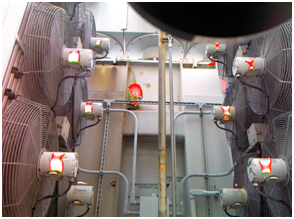Thermal Imaging - Substations
An electrical problem within the substation could mean a loss of power to hundreds or thousands of homes and businesses. When viewed from the thermographer's perspective, the components in a switchyard or distribution substation or switching station are relatively straightforward, the electricity is broken into three phases coming from the generator all the way into and out of the substation. At this point along the path from power plant to consumer, the amp load on each phase should be nearly identical, so any heating detected with the thermal imaging camera from the normal flow of electricity noted on one phase should have a similar temperature reading on the other two phases as well. Therefore, an inconsistent temperature reading, when comparing the three phases, could show a loose connection or corroded switch contact point that is heating (showing an increase in temperature).
Possible anomalies or problems –Switching Substations
When scanning a substation, the thermographer should look at all the bolted connections where the cables connect to breakers, bus bars or insulators. In addition, look at the jaw and hinge connections on cut-outs, switches and air-break connections, including jumper wires and drop lines from the cables to the bus bars.

Look, also, at bushings for possible internal heating on oil-filled components like on the breaker shown below. The use of Isotherm allows the infrared camera to highlight the problem in red.

Thermal Imaging – Transformers
Transformers are a key component of the power generation process, increasing or decreasing the voltage of electrical current. There are several key components that an infrared thermographer can monitor, including isolated bus ducts, the oil filled transformer case itself, cooling fans, and cooling fins.
When taking infrared images of transformers, be on the look-out for low oil levels. Low oil levels in transformers creates a problem of a lack of oil flowing through the cooling fins, which could create overheating within the transformer, and even worse, cause possible internal faults on linkages inside the transformers. Failures, such as seized cooling fan motors, could also result in overheating of oil-filled transformers.


Provided by Thomas Kremser
www.AltheusIR.com













.svg)



_fuben.jpg)

